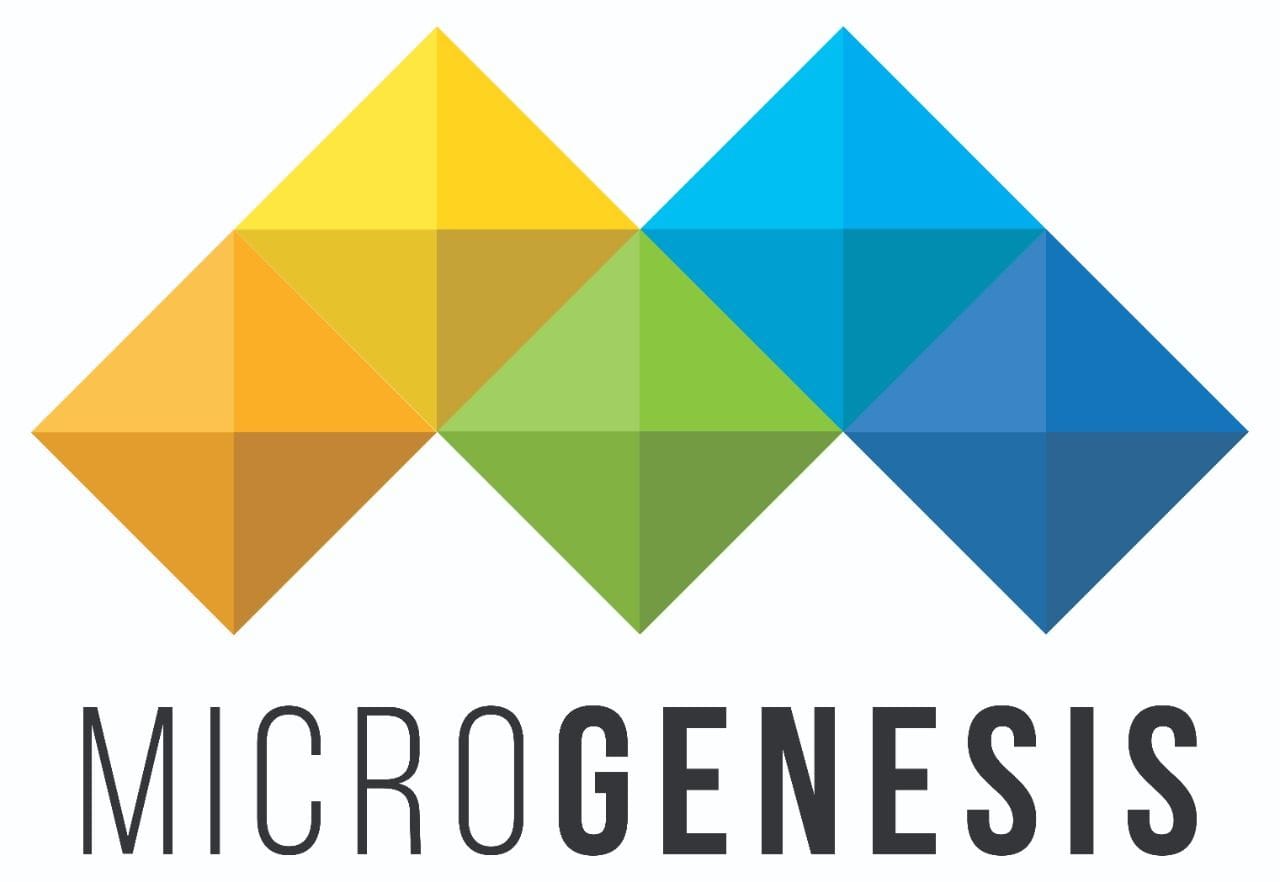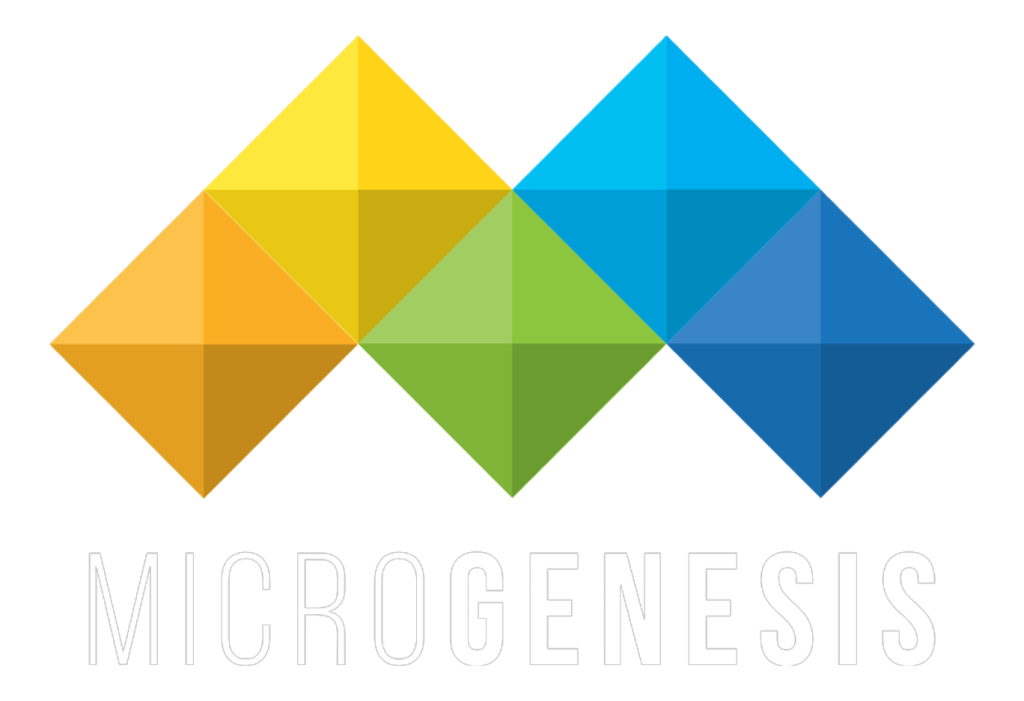Table of Contents
Introduction
Application modernization is no longer optional—it is essential for organizations that want to remain competitive, scalable, and digitally agile. With the rise of cloud computing, DevOps, and low-code platforms, enterprises are rethinking how legacy applications can be transformed to support modern business needs.
This guide provides a strategic and technical walkthrough to help IT leaders, architects, and developers understand and succeed in their modernization journeys.
What is Application Modernization?
Application modernization refers to the process of updating, transforming, or rearchitecting legacy applications to align with current technology stacks, infrastructure, and business requirements. It includes converting monolithic apps into microservices, migrating workloads to the cloud, and implementing modern DevOps pipelines.
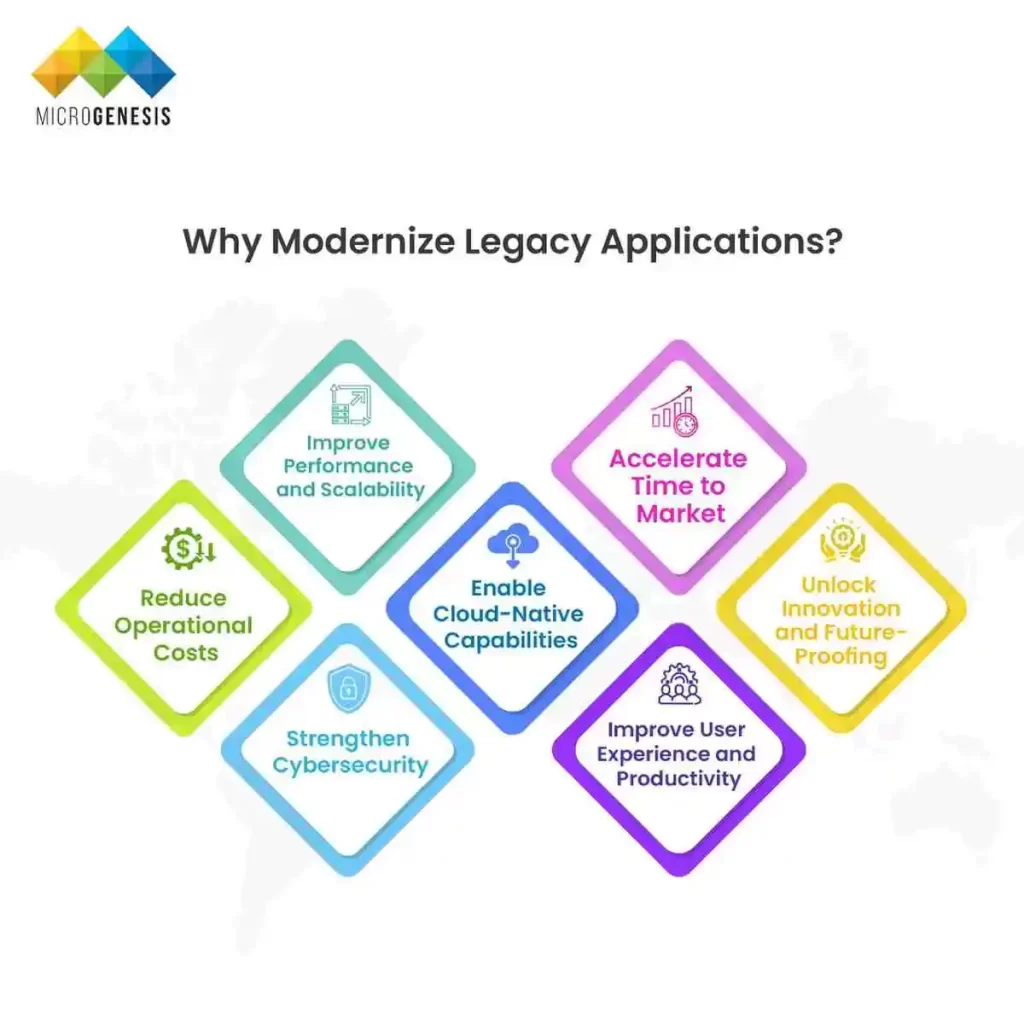
Why Modernize Legacy Applications?
Modernizing legacy applications is no longer optional—it’s a strategic initiative that empowers businesses to remain competitive, scalable, and secure in an ever-evolving digital environment. Below are the key reasons to modernize, with detailed benefits outlined both in narrative form and supporting bullet points.
1. Reduce Operational Costs
Legacy systems are expensive to maintain. They demand specialized skill sets, are often tied to outdated hardware, and incur high licensing and infrastructure fees. These costs limit your ability to invest in innovation and divert resources from strategic priorities.
Benefits of cost reduction through modernization:
- Eliminate high maintenance and support costs for outdated systems
- Reduce licensing fees tied to proprietary technologies
- Consolidate infrastructure using cloud or container platforms
- Minimize manual processes with automation
- Free up IT budget for innovation and R&D
2. Improve Performance and Scalability
Outdated applications struggle to meet the performance expectations of today’s users. They also lack the flexibility to scale as workloads grow or change—leading to bottlenecks and downtime.
Performance and scalability enhancements include:
- Faster load times and response speeds
- High availability during peak loads
- Ability to auto-scale with business demand
- Better user experience due to reliable system behavior
- Real-time data access and processing capabilities
3. Strengthen Cybersecurity
Older systems are vulnerable to attacks due to outdated encryption, insecure integrations, and lack of compliance with modern security standards. Modernized applications are built with security-first architecture, reducing your risk exposure.
Security benefits of modernization:
- Enforced data encryption (at rest and in transit)
- Role-based access control (RBAC) and single sign-on (SSO)
- Integration with modern threat detection and monitoring tools
- Easier alignment with regulatory frameworks (e.g., GDPR, HIPAA)
- Automated patching and security updates
4. Enable Cloud-Native Capabilities
Modern cloud infrastructure offers scalability, agility, and cost efficiency. Legacy applications can’t fully utilize cloud services due to architecture incompatibilities. Modernizing allows organizations to refactor or replatform applications for the cloud.
Cloud-native advantages:
- On-demand resource allocation and cost savings
- Support for containers and orchestration (Docker, Kubernetes)
- Serverless computing and microservices design
- Geographic redundancy and disaster recovery
- Integration with SaaS, PaaS, and IaaS platforms
5. Accelerate Time to Market
Legacy systems often delay feature releases and fixes. With modern DevOps tools and Agile processes, development cycles become faster and more adaptive—reducing your time to market significantly.
Speed and agility improvements:
- Implement CI/CD pipelines for faster deployments
- Frequent and incremental feature releases
- Reduced QA bottlenecks with automated testing
- Faster bug detection and rollback capabilities
- Rapid response to market or customer needs
6. Improve User Experience and Productivity
Modern users expect seamless, intuitive, and responsive applications. Legacy systems typically have clunky interfaces and offer poor user experiences. Modernization gives teams the opportunity to redesign user flows and improve overall usability.
User experience upgrades include:
- Clean, responsive interfaces optimized for web and mobile
- Personalized user journeys and dashboards
- Improved accessibility and multi-language support
- Faster load times and fewer system errors
- Higher adoption and satisfaction among users
7. Unlock Innovation and Future-Proofing
Legacy systems hold businesses back from leveraging emerging technologies like AI, IoT, and blockchain. By modernizing, organizations position themselves to innovate faster and adapt to change with confidence.
Strategic innovation advantages:
- Integrate seamlessly with AI/ML engines for smart features
- Enable IoT-based data collection and analysis
- Adopt digital twins for real-time modeling
- Prepare for regulatory changes with modular design
- Stay competitive with evolving tech trends
Common Drivers of Modernization
Modernization initiatives are often triggered by practical, strategic, or regulatory needs. Businesses today face rapidly evolving technology landscapes and shifting market expectations, making it essential to update aging systems.
Below are the most common reasons companies begin their modernization journey:
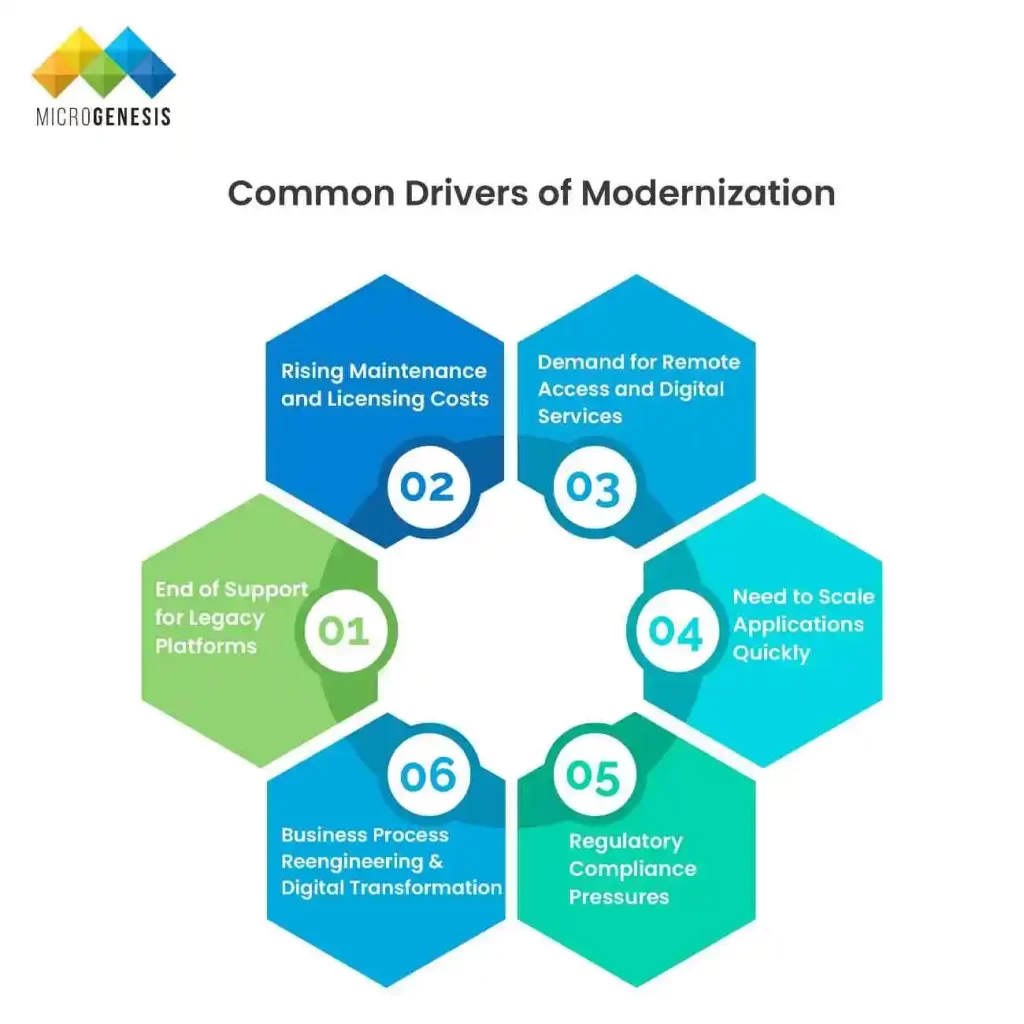
1. End of Support for Legacy Platforms
When vendors discontinue support for older software or hardware, continuing to use them becomes a major risk—security updates stop, and integration becomes difficult.
Key impacts:
- No more patches or bug fixes
- Security vulnerabilities increase
- Compatibility with new tools is limited
2. Rising Maintenance and Licensing Costs
Legacy systems often require specialized skills and expensive contracts to maintain. Costs add up, especially when performance lags behind modern alternatives.
Modernization can help:
- Lower infrastructure and support expenses
- Eliminate legacy licensing fees
- Consolidate technology stacks
3. Demand for Remote Access and Digital Services
The modern workforce and customer base expect access anytime, anywhere. Legacy apps struggle to support remote access and cloud integration.
What modernization enables:
- Cloud-based access across devices
- Better user experience for remote teams
- API-based services for external users
4. Need to Scale Applications Quickly
Businesses need systems that can grow with them. Older applications weren’t built to scale on-demand or handle global user bases.
Modern systems allow:
- Auto-scaling in cloud environments
- Load balancing and performance tuning
- Rapid deployment of new features
5. Regulatory Compliance Pressures
Regulations like GDPR, HIPAA, or SOX require secure data handling, audit trails, and transparency—features legacy systems often lack.
Benefits of modernization include:
- Easier compliance with industry standards
- Built-in audit logs and access controls
- Real-time data monitoring and reporting
6. Business Process Reengineering & Digital Transformation
Digital transformation often demands streamlined, automated, and data-driven processes. Legacy apps can’t support modern workflows or integrate well with new tools.
Modernization supports:
- Automation and workflow optimization
- Real-time analytics and decision-making
- Cross-platform integration with modern tools
Challenges in Application Modernization
Modernizing legacy applications offers immense benefits, but the path is often filled with complexity. Enterprises may face technical, organizational, and operational challenges that can delay or derail progress if not properly addressed.
Here are the key hurdles commonly encountered:

1. Lack of Documentation
Legacy systems are often poorly documented, especially if built over decades. This makes it difficult to understand dependencies, logic, and structure during modernization.
Key risks:
- Hard to map system architecture
- Increases migration errors
- Slows down analysis and planning
2. Tightly Coupled Systems
Older applications are usually monolithic, with deeply intertwined components. Updating one part can break others, making modernization risky and time-consuming.
Key risks:
- Difficult to separate components
- Refactoring requires extensive rework
- Limited scalability and agility
3. Data Silos and Compatibility Issues
Legacy databases and applications may store data in proprietary or outdated formats. Moving this data into modern systems requires careful planning and transformation.
Challenges include:
- Data loss during migration
- Inconsistent formats or duplicate records
- Integration with cloud or modern tools is difficult
4. Downtime Risks During Migration
When systems are taken offline for updates or data transfer, business operations may suffer. Even short downtimes can affect revenue and customer satisfaction.
Mitigation needs:
- Strong rollback plans
- Use of phased or parallel deployments
- Continuous monitoring and testing
5. Skill Gaps in Modern Technology
Many IT teams are experienced in legacy systems but may lack expertise in cloud, DevOps, containerization, or microservices—technologies often central to modernization.
Consequences include:
- Longer learning curves
- Misconfigured cloud services
- Dependency on third-party consultants
6. Change Management & Cultural Resistance
Modernization is not just technical—it changes how teams work. Employees may resist new tools, fear job displacement, or struggle to adapt.
Barriers to success:
- Lack of user adoption
- Ineffective training programs
- Misalignment between IT and business units
Why a Mitigation Plan Is Critical
Given these challenges, organizations should begin with a clear assessment, including:
- Inventory of systems and dependencies
- Identification of quick wins vs. high-risk areas
- Roadmap with phased modernization stages
- Budgeting for training and support
A well-defined strategy and stakeholder alignment are essential to reduce risk and ensure a successful transformation.
Core Strategies of Application Modernization
Modernization isn’t one-size-fits-all. Organizations must select a strategy that aligns with their technical environment, business goals, and available resources.
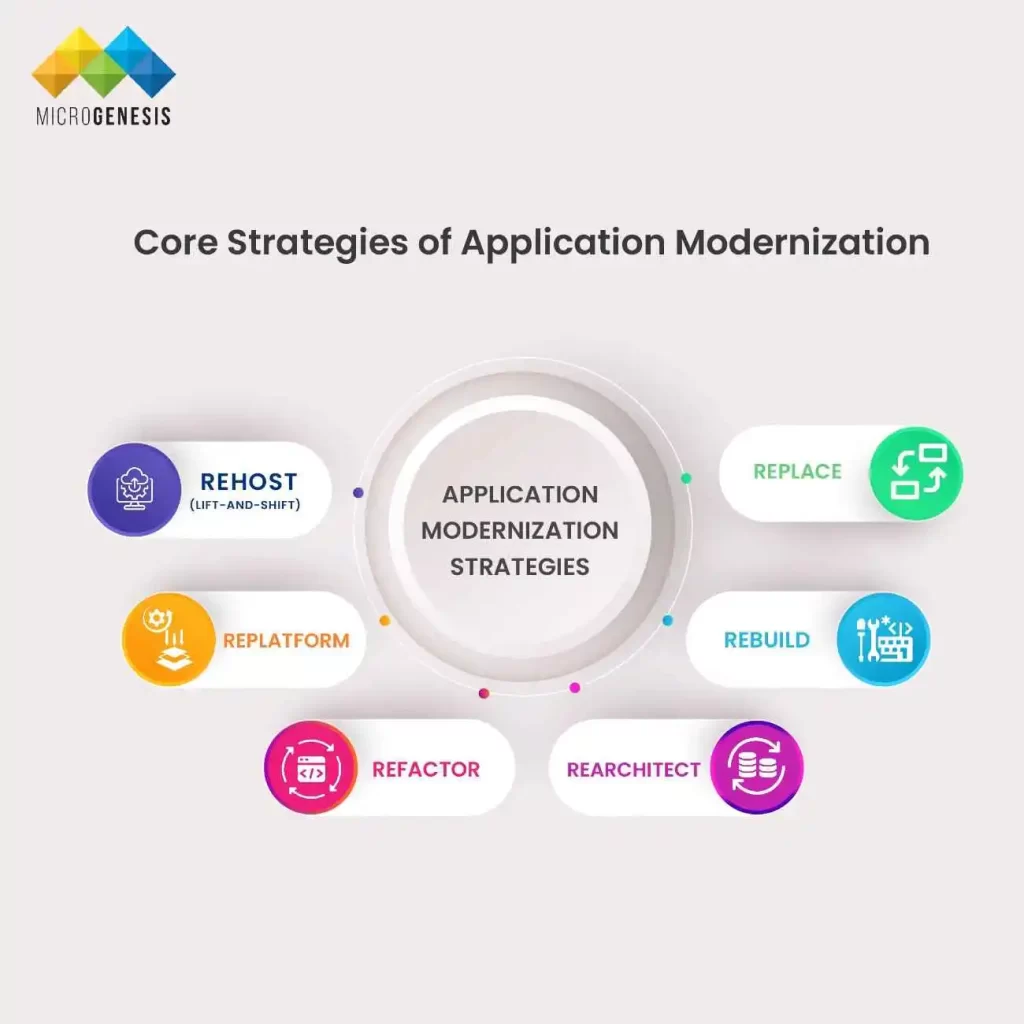
🔁 Rehost (Lift-and-Shift)
Move existing applications to new infrastructure—usually cloud—without altering code.
- Fastest and lowest risk
- No major changes to architecture
- Ideal for quick cost savings or cloud migration
🔧 Replatform
Make minimal adjustments to applications while shifting to a modern platform.
- Optimize for performance or cost
- Some changes to middleware or databases
- Balances speed with improvement
🛠 Refactor
Restructure the internal codebase without changing external behavior.
- Improves maintainability and scalability
- Often used to introduce microservices
- Higher effort, but preserves functionality
🏗 Rearchitect
Redesign the application’s architecture to fit cloud-native or modular frameworks.
- Enables high scalability and flexibility
- Suitable for monolith-to-microservices transformation
- More time-consuming, but future-ready
🧱 Rebuild
Rewrite the entire application using modern tech stacks.
- Fully optimized for current and future needs
- High investment and time required
- Best when legacy systems no longer support the business
🔄 Replace
Retire the old system and adopt a commercial SaaS or COTS (Commercial Off-The-Shelf) product.
- Quickest way to gain new functionality
- Reduces technical debt
- May involve adapting business processes
Modernization Techniques and Approaches
To successfully modernize legacy applications, organizations often apply a combination of modern technologies and architectural approaches. These techniques enhance flexibility, scalability, and maintainability.
🧩 Microservices Architecture
Break monolithic applications into smaller, independent services that can be developed, deployed, and scaled individually.
- Promotes agility and faster releases
- Enables easier troubleshooting and updates
- Supports parallel development teams
📦 Containerization (Docker, Kubernetes)
Package applications and their dependencies into containers for consistent deployment across environments.
- Simplifies DevOps and CI/CD processes
- Improves scalability and resource efficiency
- Reduces conflicts between environments
⚡ Event-Driven Architecture
Design systems around events (e.g., actions or changes) that trigger automatic responses.
- Enables real-time responsiveness
- Supports loosely coupled systems
- Ideal for dynamic, distributed applications
🔗 API-First Design
Prioritize building reusable, well-documented APIs before the application’s frontend or services.
- Ensures integration readiness
- Improves developer experience
- Supports omnichannel and partner ecosystems
🛢 Database Modernization
Update legacy databases to modern cloud-native or NoSQL systems.
- Improves query performance and scalability
- Enhances data availability and replication
- Reduces vendor lock-in
💻 Front-End Refresh with Responsive Design and PWAs
Revamp user interfaces to be mobile-friendly and modern using technologies like Progressive Web Apps (PWAs).
- Enhances user experience across devices
- Reduces app load times and increases engagement
- Supports offline functionality and native-like features
Each of these techniques plays a role in decoupling monoliths and enhancing system flexibility.
Tools & Technologies
Successful application modernization requires the right technology stack. Here are essential categories and tools that power modern transformation initiatives:
☁️ Cloud Platforms
Enable scalable, flexible, and cost-effective infrastructure for modernized applications.
- Amazon Web Services (AWS) – Extensive cloud services for compute, storage, AI, and DevOps
- Microsoft Azure – Enterprise-grade platform with strong integration for hybrid and .NET workloads
- Google Cloud Platform (GCP) – Focuses on AI, Kubernetes, and developer-friendly tools
🔧 DevOps & Automation Tools
Automate the software delivery pipeline and enforce infrastructure-as-code (IaC).
- Jenkins – Open-source CI/CD automation server
- GitLab CI/CD – Integrated DevOps platform for automation and collaboration
- Terraform – Infrastructure as code to manage cloud resources declaratively
📦 Containerization & Orchestration
Package and manage applications consistently across environments.
- Docker – Standard for creating lightweight, portable containers
- Kubernetes – Industry-leading container orchestration platform for scalability and resilience
📈 Monitoring & Observability
Track application health, performance, and reliability post-modernization.
- Prometheus – Metrics-based monitoring and alerting
- Grafana – Powerful visualization and analytics dashboards
- Datadog – Cloud-based observability for infrastructure, apps, and logs
🔗 API Management & Integration
Facilitate service-to-service communication, external integrations, and governance.
- Apigee – Google’s full lifecycle API management platform
- Postman – Collaboration tool for designing and testing APIs
- MuleSoft – Enterprise integration and API platform
🛢 Modern Databases
Support scalability, flexibility, and real-time access in cloud-native applications.
- PostgreSQL – Powerful open-source relational database
- MongoDB – Popular NoSQL database for high-volume, flexible data
- Amazon Aurora – Cloud-optimized relational database engine with high availability
Cloud & DevOps Role in Modernization
Cloud platforms offer:
- Scalable infrastructure
- Pay-as-you-go flexibility
- Native services like AI/ML, data lakes, security tools
DevOps practices bring:
- Continuous integration & delivery (CI/CD)
- Infrastructure as code (IaC)
- Automated testing and deployment
Together, they form the backbone of agile application modernization.
Modernization Roadmap (Step-by-Step)
Application modernization is not a one-time event—it’s a strategic journey. Below is a streamlined step-by-step roadmap to guide organizations through a successful transformation:
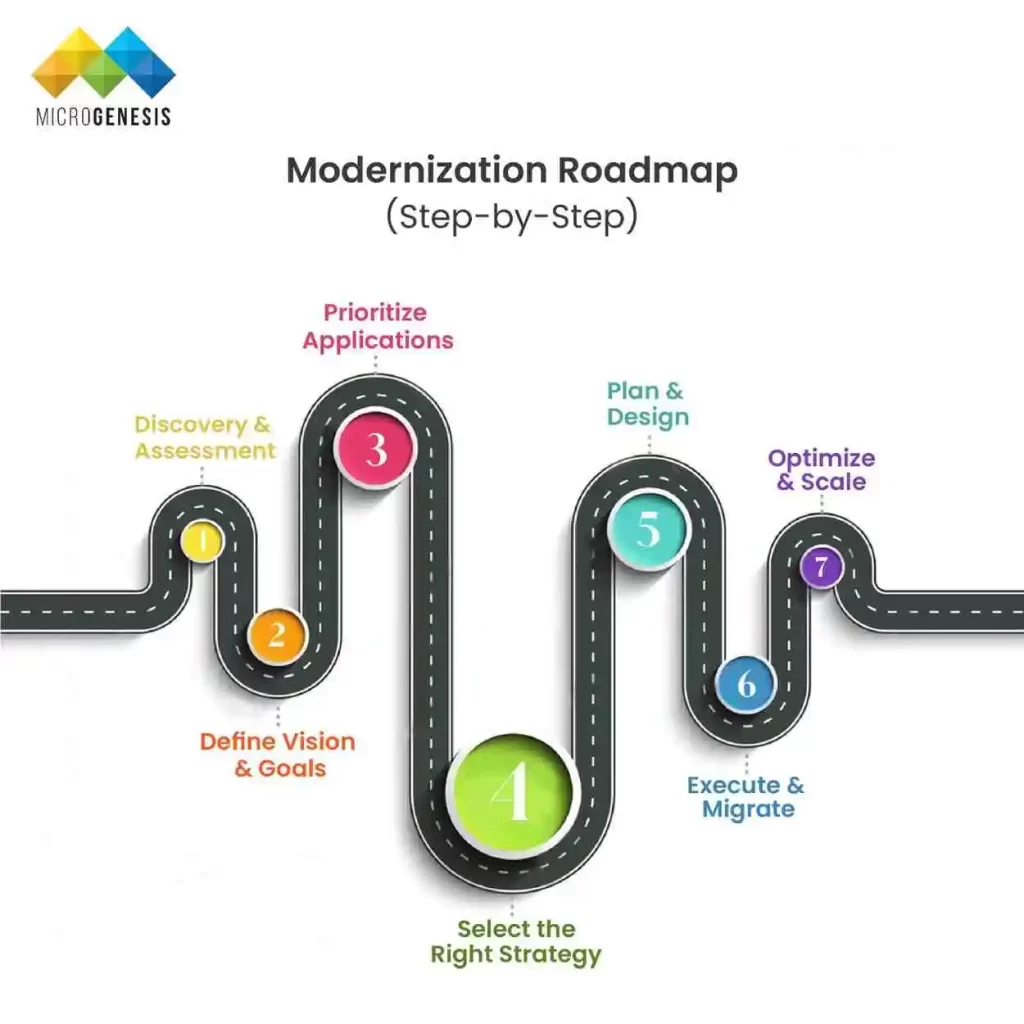
1. Discovery & Assessment
Before any modernization begins, a complete inventory and evaluation of the existing application landscape is crucial.
- Catalog all applications and dependencies
- Assess each app’s technical debt, performance, and support status
- Identify bottlenecks, risk areas, and compliance issues
📝 Outcome: A clear understanding of what exists and what needs improvement.
2. Define Vision & Goals
Modernization should align with both business and technical objectives.
- Identify what you want to achieve (e.g., cost savings, agility, innovation)
- Define success metrics (KPIs), compliance targets, and business value
- Get stakeholder buy-in early
📝 Outcome: A clear vision and shared understanding of expected benefits.
3. Prioritize Applications
You don’t need to modernize everything at once. Prioritization reduces risk and maximizes impact.
- Classify apps based on complexity, value, and urgency
- Start with high-impact, low-complexity systems
- Delay or phase out apps with limited business value
📝 Outcome: A rational modernization sequence and phased rollout plan.
4. Select the Right Strategy
Choose a modernization approach that aligns with your goals, constraints, and risk appetite.
- Rehost: Lift-and-shift with minimal changes
- Refactor: Improve internal code structure
- Replatform: Move to a modern runtime with minor updates
- Rebuild or Replace: Develop new applications or adopt SaaS
📝 Outcome: A targeted and appropriate strategy per application or system group.
5. Plan & Design
A detailed blueprint ensures a smooth migration and reduces surprises.
- Define technical architecture and design for scalability and cloud compatibility
- Plan data migration, integration touchpoints, and APIs
- Set up KPIs, monitoring goals, and rollback plans
📝 Outcome: A comprehensive plan with clear checkpoints and responsibilities.
6. Execute & Migrate
Put your strategy into action through careful, phased execution.
- Run pilot projects to validate designs
- Migrate systems incrementally to control risk
- Perform continuous testing and validation during rollout
📝 Outcome: Functionally migrated systems with minimal downtime and disruption.
7. Optimize & Scale
Post-migration is just as critical—modernization is an ongoing process.
- Monitor performance, user feedback, and operational metrics
- Use DevOps automation to enhance scalability and resilience
- Continually refactor and optimize to adapt to business evolution
📝 Outcome: A future-proof application ecosystem that continuously delivers value.
Governance, Risk, and Compliance
To modernize securely:
- Ensure data protection and privacy (e.g., GDPR)
- Define access controls and IAM policies
- Maintain audit logs and versioning
- Establish disaster recovery and backup plans
- Comply with industry standards (ISO, HIPAA, SOC2)
Key Industries Embracing Modernization
Modernization impacts all sectors, but some lead in adoption:
- Banking & Financial Services: Moving from mainframes to digital apps
- Healthcare: Electronic Health Records (EHRs) and secure APIs
- Manufacturing: Integration with IoT and smart factory systems
- Government: Cloud-first mandates and public service digitization
- Retail: Omnichannel platforms and personalized experiences
Measuring Success of Modernization
Post-modernization KPIs include:
- Reduction in downtime and incidents
- Deployment frequency and time to recovery
- Operational cost savings
- Application performance and responsiveness
- User satisfaction and adoption rates
- Regulatory compliance audit results
Best Practices for Seamless Transformation
- Start with clear business objectives
- Build cross-functional teams (IT, business, QA, security)
- Leverage Agile methodologies and sprints
- Document dependencies and test thoroughly
- Use automated testing and CI/CD pipelines
- Prioritize cloud-native over lift-and-shift
- Don’t forget user training and change management
Conclusion
Application modernization is not just a technical upgrade—it’s a business transformation strategy. As industries evolve, modern, flexible, and scalable digital ecosystems are foundational to innovation and competitive growth.
Whether you’re modernizing a legacy ERP or building cloud-native services, a well-planned modernization roadmap ensures success.
Our Blogs


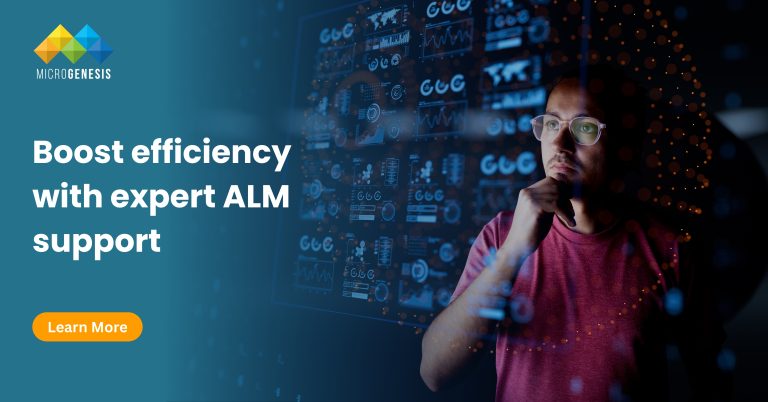
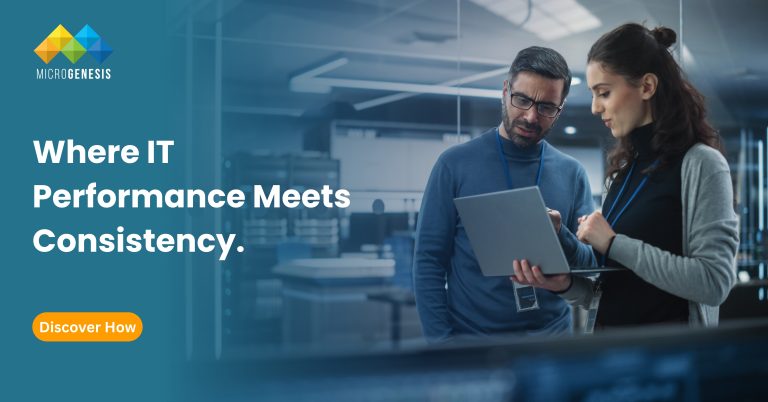


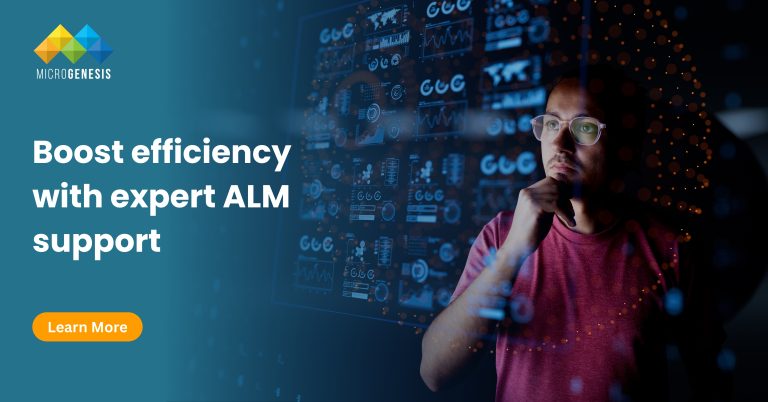
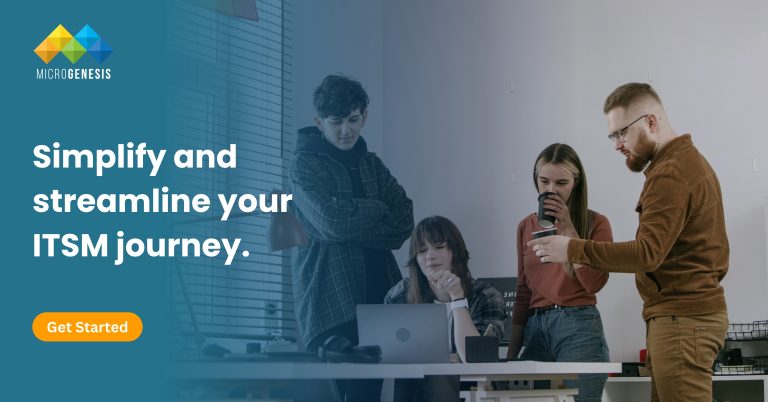


Copyright © 2025 MICROGENESIS. All Rights Reserved.
